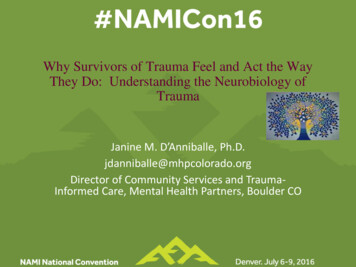
Transcription
Why Survivors of Trauma Feel and Act the WayThey Do: Understanding the Neurobiology ofTraumaJanine M. D’Anniballe, Ph.D.jdanniballe@mhpcolorado.orgDirector of Community Services and TraumaInformed Care, Mental Health Partners, Boulder CO
The Stress-Trauma Continuum Normal Situational Traumatic
What is Trauma? Physical, sexual abuse, neglectDomestic violenceStalkingChronic marginalizationSchool or gang violenceDivorce/custody battleLossesImmigrationWarNatural DisastersSevere motor vehicle accidentsWitnessing or hearing about any of the above
Trauma Symptoms as Adaptations Substance abuse Indiscriminant sexual behavior Self-harm and suicidal gestures Dissociation Fighting Continued contact with the abuser The freeze response Avoidance or withdrawal Eating disorders Engaging in high risk behaviors
Neurobiology of Trauma
Synaptic Activity
More on the Sympathic Nervous System Response HPA axis: hypothalamic-pituitary-adrenal This system is responsible for bringing the body back intobalance The following chemicals/hormones are released: Catecholamines (epinephrine and norepinephrine) –responsible for fight or flight Corticosteroids (glucocorticoids, cortisol) – control energyand body’s immune functioning Opiods – prevent pain, inhibit memory consolidation Oxytocin – inhibits memory consolidation, promotes goodfeelings These chemicals are POWERFUL substances .
Sympathic Nervous System Response If trauma is too severe, too long, triggered often then: Catecholamines are chronically increased; damage tomemory, rational thought, hypervigilance, inability todistinguish danger signals Corticosteroids are chronically low; reduced immunefunctioning (lupus, Graves disease, RA, fibromyalgia),catecholamines aren’t regulated Opiod levels increase (equivalent to 8 mg of morphine); flataffect Oxytocin increased– memory impaired; bonding to perp
Other Neurotransmitters of Importance Serotonin – inhibitory; involved in emotion andmood. Too little serotonin has been shown to leadto depression, problems with anger control,obsessive-compulsive disorder, and suicide. Dopamine – inhibitory (meaning when it findsreceptor sites, it blocks the firing of the neuron);controls arousal, alertness, attention; vital for givingmotivation; Drugs like cocaine, opium, heroin, andalcohol increase the levels of dopamine, as doesnicotine. GABA – inhibitory; acts like a brake to theexcitatory neurotransmitters that lead to anxiety.
Structures of the Brain: The LimbicSystem
Hebb’s Rule: Neurons that FireTogether Wire Together” Brain neurons connect with other neurons or change(chemically and structurally) in response to signalsfrom the environment (experiences) and creatememories (cognitive, behavioral, emotional,physical) The more often neural connections are made thestronger these connections become Synaptic pruning: in adolescents, the brain beginsto break down the least used connections andstrengthens the most used.
Hippocampal Volume Reduction in PTSDNORMALPTSDMRI scan of the hippocampus in a normal control and patient withPTSD secondary to childhood abuse. The hippocampus, outlined inred, is visibly smaller in PTSD. Overall there was a 12% reduction involume in PTSD.
The Prefrontal Cortex Highly developed in primates and humans Allows “executive control” – or at least guidance –over more primitive brain structures Middle region is critical to relational functioning,empathy, connecting Helps us with: Being able to focus Memory and reason Self-awareness, reflection, emotions, impulses
The Prefrontal Cortex (PFC) Connected with the amygdala andexerts inhibitory control over stress responses andemotional reactivity; goals, reason, controls habits Prefrontal cortex actually shrinks with PTSD;children/adolescents/young adults don’t havedeveloped PFC Successful SSRI treatment restored PFC activationpatterns
Fight, Flight, or Freeze A lesson from Jakey Cat
Jakey Cat (RIP)
The Freeze Response:Tonic Immobility Autonomic Nervous System:sympathetic andparasympathetic nervoussystem Both systems heightenedsimultaneously underextreme stress Tonic immobility as anadaptive survival response; ifyou move in the animalworld – the predator willchase and kill
If you don’t remember anything fromthis presentation, remember . The more the neural system is activated, the more itwill change What fires together, wires together Trauma leads to dysregulation of the autonomicnervous system and the limbic system; the past ispresent neurobiologically Memory is often impacted by trauma; recall is lessexplicit, more implicit
Healing Strategies that AddressNeurobiological Issues The “helping” relationship (can betherapeutic, first responder, any systemresponse)"There is no more effectiveneurobiological intervention than a saferelationship"-- Bruce Perry
The Importance of Relationship Oxytocin and vasopressin are linked to bonding andrelationships characterized by strong attachments. Positive attachments directlyrewire the wiring of the orbitofrontal cortex to the Limbicsystem to mediate emotionalresponse; balance sympatheticand parasympathetic systems
Importance of Empowerment Making decisionsdevelops the cortex Involve clients intreatment decisions. Avoid using relationshipsas consequences (e.g.,restricting family visits,peer connections)
Engaging and Exercising the Brain: NeurobicsIt is important to challenge the brain to learn new tasks Learn new content/skills Break routines Try new things: switch chores, change foods, newmusic Expose yourself to new environmental stimuli (smells,tastes, changing your visual field)
Patterned, repetitive, rhythmicactivity brainstem regulation Walking Running Dancing Singing Chanting Drumming
Transforming from the Sympathetic tothe Parasympathic System The more anxiety we have, the less optimally ourbrains function Sympathetic System Ready to react, on alert, high arousal Parasympathic System Relaxed, comfortable, intentional, optimal functioning
Safe Physical Contact(with humans or animals) Touch lowers cortisol,increases limbicbonding Massage Contact with animals:lowers cholesterol, bloodpressure, and triglyceridelevels
Meditation/Mindfulness Practice:the power of focused attention Thickens the cerebralcortex (due to trauma,age) Increases attentionspan, sharpens focus,improves memory Restores synapses,similar to sleep
The Power of Yoga to Heal Trauma Trauma Split between mind and bodyYoga Unifying mind and body
YogaTrauma split between mind and bodyYoga unifying mind and body Yoga increases heart rate variability(HRV); an indicator of the body’sability to respond more flexibly tostress Benefits of controlled breathingactivates parasympathetic systemsimilar to those receiving ECT, andtaking an antidepressant 2010 study from Boston U. Schoolof Medicine; yoga increasingGABA levels (GABA involved inalcohol use)
Yoga and Heart Rate Variability(HRV) HRV is the variation in the time interval between one heartbeat and the next.When you inhale, heart rate speeds up; when you exhale it slows down.When HRV is high, a person experience lower levels of stress and greatresiliency. Dozens of research studies show that yoga of all kinds (Vinyasa,Hatha, Yoga Nidra) increases HRV.
The Neurobiology of Yoga Yoga increases Gammaaminobutyric (GABA) levels in thebrain (measured by fMRIs) Low GABA levels are associatedwith depression and anxiety Activate the GABA receptors withambien, xanax, or a glass of wine,and you get relaxed and sleepy.When these substances areconstantly in the brain and thenrapidly withdrawn, you suddenlyhave overexcited GABA receptorsand you can get side effects such asinsomnia, anxietyStreeter et al., Effects of Yoga Versus Walking on Mood, Anxiety, and BrainGABA levels: A Randomized Controlled MRS Study. The Journal of Alternativeand Complementary Medicine, 2010.
Exercise: Rebalances melatonin; enhances sleep cycle Releases endorphins (endogenous opioids) Promotes tryptophan which enhances mood;precursor to serotonin
What’s the worst thing you can do with someone whojust experienced or is re-telling the trauma?
What we can learn from animalswho experience trauma
Sleep, Rest, and Relaxation Sleep deprivationkeeps nervoussystem on highalert; cortisol iselevated Serotonin anddopamine risewhen sleeping,resting
Diet The brain reads a drop in blood sugar as “danger” andbegins to produce adrenaline. Adrenaline can be produced ina split second, leaving one feeling tense, jittery, weak, anddizzy. With someone who suffers from PTSD, these constantdrops in blood sugar can cause mood swings into panic,anger or desperation Avoid stimulants (sugars, caffeine, non-herbal tea, nicotine,and simple carbohydrates such as white bread, white rice,cakes, cookies, candy bars, soda and ice cream) Avoid packaged foods with high sodium – this can turncortisone into cortisol avoid some fruit like bananas, grapefruit, melons, honey, anddates because they are high in sugar content
Eating to Manage PTSD Foods to Help Decrease Cortisol: Whole grain breads and cereals, oat bran, oatmeal, beans,citrus fruits, strawberries, beets and carrots. Vitamin C – found in foods such as green peppers, citrusfruits, tomatoes, strawberries, broccoli, sweet potatoes andcantaloupe Whey Protein - The tryptophan found in whey proteinincreases the levels of serotonin in the brain and lowers thelevels of cortisol in the body. Try a protein shake or combineit with milk, fruit, yogurt and peanut butter for a healthy,low-calorie and cortisol-fighting smoothie.
Contact Information:Janine M. D’Anniballe, Ph.D.jdanniballe@mhpcolorado.org
Whole grain breads and cereals, oat bran, oatmeal, . Whey Protein - The tryptophan found in whey protein increases the levels of serotonin in the brain and lowers the levels of cortisol in the body. Try a protein shake or combine it with milk, fruit, yogurt and peanut butter f

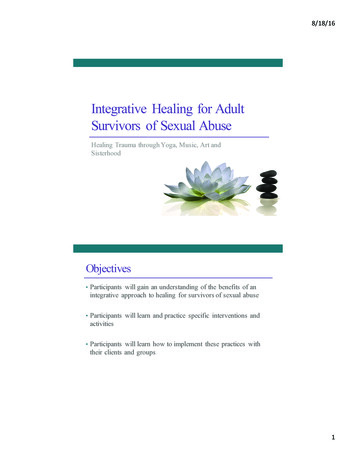


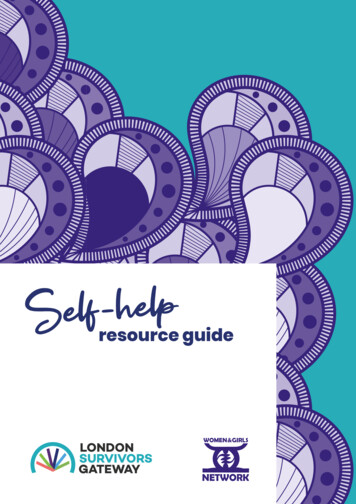
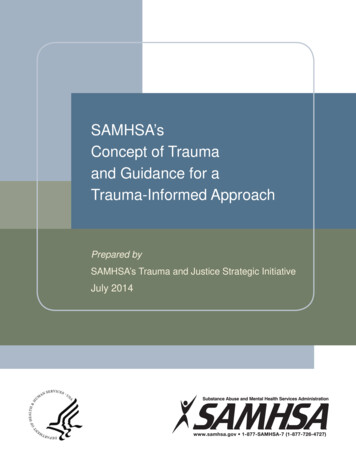
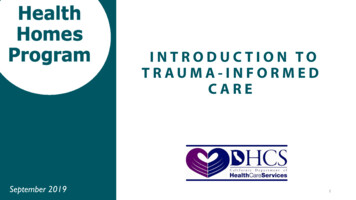

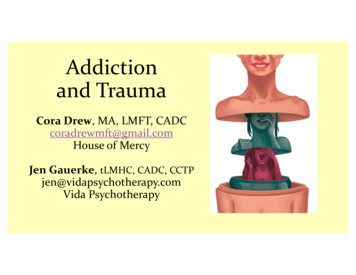

![[Page 1 – front cover] [Show cover CLEAN GET- AWAY 978-1 .](/img/13/9781984892973-6648.jpg)